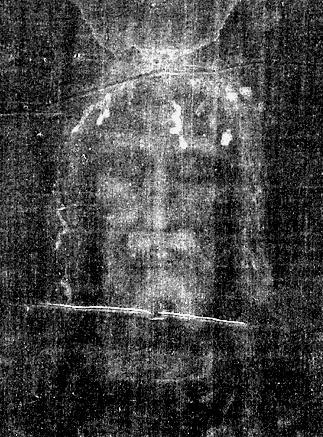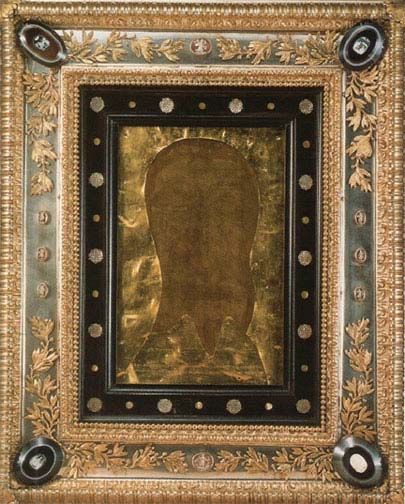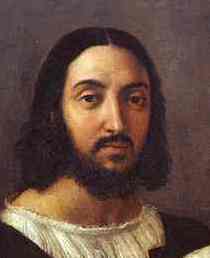
Posted on 06/09/2006 3:31:39 PM PDT by NYer

Almost four centuries after its mysterious disappearance, Fr. Heinrich Pfeiffer reported that he has rediscovered one of Christendom's most intriguing relics: the Veil of Veronica, the cloth with which Jesus wiped His face on the road to Calvary.
Fr. Pfeiffer, a professor of Christian Art History in Rome, found the relic in the Abbey of Manoppello, Italy. The German Jesuit invested 13 years of searching through archives to prove that this is the same cloth that disappeared from the Vatican in 1608. Stolen, Sold and Donated The Same Face as the Shroud
Manoppello is a small, ancient town in the Abruzzo region of Italy, about 150 miles from Rome in the Apennine Mountains. The Capuchin friary there is appropriately named the Sanctuary of the Holy Face. A piece of stained, pale cloth kept in this tiny village has long been regarded by the Capuchin monks as a sacred icon with wondrous properties.
The story of St. Veronica and her veil appears in various early Christian writings. Most notably, the apocryphal "Acts of Pilate" from the sixth century, identifies Veronica with the hemorrhaging woman who was cured by touching the hem of Jesus' cloak. Veronica is described as a pious matron from Jerusalem, and numbered among the holy women who accompanied our Lord to Calvary.
During the Passion, she is said to have wiped sweat from His brow. Jesus rewarded Veronica for her charity by leaving her an imprint of His face on the "veil." She later traveled to Rome, bringing with her this image of Christ, which was long exposed to public veneration.
The almost transparent white veil measures about 6-1/2 x 9-1/2 inches and bears dark red features of a serene bearded man with long hair and open eyes, patiently enduring suffering. Bruises and other scars are apparent on his forehead. Clotted blood is on his nose, and one pupil is slightly dilated.
The sacred veil is so thin one can easily see through it. In fact, the image becomes invisible depending on the angle from which the cloth is viewed, something that was considered a miracle in itself in medieval times.
Documented history of the mysterious relic dates back to at least the fourth century. On the occasion of the first known Jubilee year, 1300, we know that the veil was kept in the Vatican Basilica as a popular goal of pilgrims, as it is mentioned in Canto XXXI of Dante's Paradiso. Fr. Pfeiffer believes the sacred relic was stolen during the restoration of the Basilica in the year 1608., when the chapel housing the veil was demolished. Shortly thereafter, the veil appeared in Manoppello.
Ten years later, in 1618, Vatican archivist Giacomo Grimaldi drew up a list of the sacred objects held in the old St. Peter's Basilica. The reliquary containing the Veil of Veronica was on that list, but Grimaldi indicated that the reliquary's crystal glass was broken.
According to records at the monastery written in 1646, the wife of a soldier sold the veil to a nobleman of Manoppello in 1608 in order to ransom her husband from prison. Thirty years later, the nobleman donated the relic to the Capuchins. In 1638, it was placed in a walnut frame adorned in silver and gold between two sheets of glass. It remained in the monastery ever since.
"There are few such objects in history," Fr. Pfeiffer explained to Rome's Zenit News Agency a few years ago. "This is not a painting. We don't know what the material is that shapes the image, but it is the color of blood."
Ultraviolet examinations of the cloth confirm that the image is not paint, and the fibers of the veil do not have any type of color. Thus, it was not woven with dyed fibers. Particularly noteworthy are several small flecks of reddish brown — presumably drops of blood from the wounds caused by the Crown of Thorns.
Enlarged digital photographs of the veil reveal that the image is identical on both sides of the cloth — a feat impossible to achieve by ancient techniques, and extremely difficult to achieve even today. These photographs have also been used to compare the veil with the face on the Shroud of Turin. Striking similarities are apparent: the faces are the same shape and size, both have shoulder-length hair with a tuft on the forehead, the noses are the same length, and the beards match. The only difference is that on the veil the mouth and eyes are open. Those who carried out the tests concluded that the two relics bear the image of the same face, "photographed" at two different times.
For those interested, the Veil of Veronica remains on display at the Capuchin Abbey of Manoppello.
LOL!! We are a CULT ya know!! My Baptist friend tells me so!
That COLORED picture is the "veil"??? Color me skeptical.
That picture in the left hand corner does NOT look like the picture that is posted...is it the same?
The JUNE 3 1999 !!! version of Fr. Pfeiffer's story
So it's been at least seven years since Fr. Pfeiffer made his "discovery" and there are still NO images on the internet besides the one Swordmaker posted in #17???
Excuse me if my skepticism starts to kick in.
Unlike the "real" Christians:

A snake, and cymbals, and a drum set. ?!?
Hey! They're not drinking or dancing though!
As to what I think.
First of all, the entire story of a woman named Veronica and her veil are somewhat suspect... the woman's very name means Vera - "True" - Icon - "Image" in a combination of Latin and Greek. While a woman may have offered her veil for Jesus to wipe his face on while carrying his cross on the Via del a Rosa, the likelyhood of her name being "Veronica" is doubtful.
Secondly, the material that the Manoppello image is on is not one that would likely be used for a sweat cloth... it would not absorb anything... or even your average veil. It is an extremely rare and costly cloth, far more costly than silk. It is still the rarest cloth on Earth. The cloth is Byssus, made from the cillia of the pinna nobilis Sea Urchin. As far as we know, there is only one living weaver of Byssal cloth still around. The cloth produced from these filaments can be woven even finer than silk and is extremely light and warm, but attracts moths which eat it. It was said that a pair of women's gloves could fit into half a walnut shell and a pair of stockings in a snuffbox. 2000 years ago it was something that was pretty much reserved for royalty.
Thirdly, most Shroud scholars are of the opinion that the various traditions of the "Veronica" and the "Mandylion" as seperate cloths arise out of the possibility that the shroud, to hide the brutal nature of the assault on Jesus' body, had been kept in a frame folded twice in four or, as it was referred to in many early references, "tetradiplong". When folded, doubled four times end over end, it is possible to have a section of the Shroud that shows only the face exposed.
Fourthly, the image on the cloth at Matoppello is hardly an exact match for the image on the Shroud... there are some distinct differences... for example, where is the mustache?


The differing widths of faces is not as important because the shroud's image is artificially narrowed by artifacting of the bleaching method which resulted in darker Linen bands on each side of the head and the face on the Shroud may be actually wider and rounder than previously thought.
Fifth, the depiction of teeth and eyes in the "veil" is problematic... There is no way they could have been created by contact... and bear an artistic appearence. These may have been added or enhanced by pious, well meaning "restorers" of a later period... or be originals from the artist who may have created the veil. The whites of the eyes are actually whiter than the imageless parts of the transparent cloth...
Lastly, the Manoppello Veil has not been subjected to any kind of scientific examiniation beyond light and ultraviolet photography. Neither of which is sufficient to determine the presence or absence of pigments. I believe the whiteness of the eyes and teeth indicate that pigments are indeed present. I would want to see much more done before making a positive judgement such as this article makes.
No. That's a photograph of it. The keepers of the veil will not allow it to be dismounted from the double sided glass fram it's held in. When it was put in the frame, it was apparently actually CUT to fit (not even a rectangular shape but sort of jagged cuts around the oval of the face)! It has the look, to me, of some medieval portraiture... a bit primitive. The mounting is also less than perfect with distortion from not being placed to best fit to anatomy.
Photographing it is also very difficult... it is up, behind the altar, and not well lighted. Given that the cloth is transparent, very diaphanous, getting a good picture in situ is almost impossible. The image is only viewable or photographical when the angle of incident light is just right. It does appear to be mysterious...
Thanks, everyone, for the informative responses! We went to the pool right after I posted the question, and then my son played "Star Wars Battlefront," and now Vlad's hungry again :-).

THANK YOU!!
Look at #31....HUGE difference!

Thanks for the ping!
Since I had not visited this topic in sometime (like about five years) I decided to go digging. Here is what I have found.
I find I was somewhat wrong in my discussion above... there has been more scientific work done on the Manoppello Veil that I was not aware of... and it proves that it is not as Pfeiffer describes... and in fact probably has identified WHAT it is, HOW it was created, and WHO it is, and WHO did it! Not only that, the work of art that it is was spoken and written about by its creator and its owner contemporary with its creation... along with a description of the work.
Albrecht Durer (1471-1528) was very fond of self portraits and often sent his own to others. Sometime in the early 16th Century, he sent a self portrait to his friend Raphael (1483- 1520) that was painted on a transparent cloth, visible from both sides and was described by Raphael and those who saw it as "miraculous".
"According to Vasari, Dürer’s self-portrait was painted in watercolour on a canvas so extremely fine that it could be seen from both the front and the back side. It was truly a piece of virtuosity, which beside immortalizing the artist’s features was clearly intended to show his painting skills."
Wolfram Prinz
Raphael, using the same technique and same Byssus cloth, painted his OWN portrait and sent it to Dürer.
“By these and other works the fame of Raphael spread to France and Flanders. Albert Dürer, a remarkable German painter and author of some fine copper engravings, paid him the tribute of his homage and sent him his own portrait, painted in water-colours, on byssus, so fine that it was transparent, without the use of white paint, the white material forming the lights of the picture This appeared marvellous to Raphael, who sent back many drawings of his own which were greatly valued by Albert...”Various persons who saw both Dürer's and Raphael's "miraculous" self-portraits described them as being made from either Byssus or Cambric. There is no consistency to the reports of either material.
Giorgio Vasari

Self Portrait of Raffaello Santi (Raphael)
c.1514

Raphael Self Portrait Gift to Dürer
now known as "Veronica's Veil"
C. 1500-1503 (?)
The Veil of Manoppello: work of art or authentic relic?
This is still research in progress but it looks very solid. As an aside, Albrecht Dürer is one of the "suspects" among those who maintain the Shroud of Turin in a "self portrait" by an artist of the period.
I think it has much more provenance than does the Manoppello Veil discussed in this article... which was purportedly STOLEN from the Vatican (who then replaced it with a "fake" that is in your picture), used to ransom a soldier, held for 30 years and then donated to a small church in a village called "Haystack".


Disclaimer: Opinions posted on Free Republic are those of the individual posters and do not necessarily represent the opinion of Free Republic or its management. All materials posted herein are protected by copyright law and the exemption for fair use of copyrighted works.